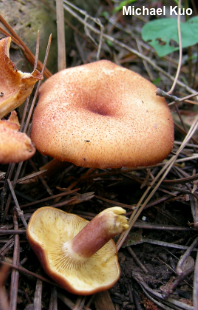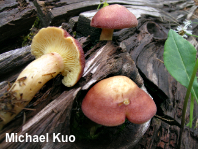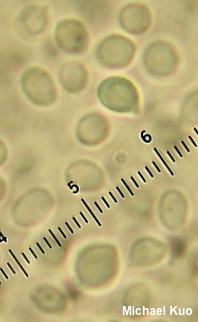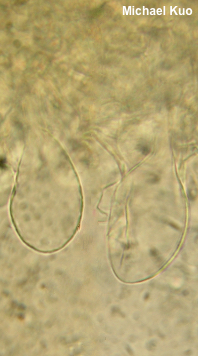| Major Groups > Gilled Mushrooms > Pale-Spored > Collybioid > Tricholomopsis rutilans |

|
Tricholomopsis rutilans [ Basidiomycota > Agaricales > Tricholomataceae > Tricholomopsis . . . ] by Michael Kuo Appearing in conifer forests across North America, Tricholomopsis rutilans is a saprobe that decays fallen wood. It is easily recognized by the densely packed, bright red to purplish red fibers and scales on the cap and stem, covering the yellow surfaces beneath almost entirely when the mushroom is young. The gills are yellow, the spore print is white, and there is no partial veil. Under the microscope, Tricholomopsis rutilans features abundant large, inflated cheilocystidia. Our North American version of Tricholomopsis rutilans may represent a separate, unnamed species, according to a contemporary DNA study (Olariaga and collaborators 2015), which found five phylogenetically separated species among the "Tricholomposis rutilans" collections studied from Europe and North America. The researchers gave a name to one of these species, Tricholomopsis pteridicola, well characterized by its association with eagle ferns in the Pyrenees and its small size. The authors also designated a Swedish type collection for the "true" Tricholomopsis decora—but felt it would be "premature" on the basis of the material studied to name and and attempt to describe other species in the complex. Description: Ecology: Saprobic on the well-decayed wood of conifers; also occasionally reported in woodchips, sawdust, and lignin-rich soil; growing alone, scattered or gregariously; summer and fall (also in winter and spring in warm climates); widely distributed in North America. The illustrated and described collections are from Colorado and Illinois. Cap: 3–10 cm; convex with an incurved margin, becoming broadly convex, broadly bell-shaped, or nearly flat; dry; densely covered with red to purplish red or brick red fibrils; with maturity the fibrils aggregating into small scales and the yellowish ground color beneath showing through. Gills: Attached to the stem; close or crowded; short-gills frequent; yellow. Stem: 3–9 cm long; 1–1.5 cm thick; yellowish, covered with red fibrils like those on the cap—but often more sparsely, especially in age; with a yellow, bald zone at the apex. Flesh: Yellow to pale yellow. Odor and Taste: Odor fragrant or not distinctive; taste mild or slightly radishlike. Chemical Reactions: KOH red on cap surface. Spore Print: White. Microscopic Features: Spores 3–5 x 2.5–5 µm; subglobose to broadly ellipsoid; smooth; hyaline in KOH; inamyloid. Lamellar trama subparallel; a bit gelatinized; clamps present. Basidia 4-sterigmate. Pleurocystidia scattered; 30–35 x 5–7 µm; sublageniform to subcylindric; smooth; hyaline in KOH. Cheilocystidia 50–70+ x 20–25 µm; sphaeropedunculate to saccate or swollen-irregular; smooth; thin-walled; hyaline in KOH. Pileipellis a cutis with trichodermial areas; elements 10–20 µm wide, smooth, orangish-walled in KOH; clamps present. REFERENCES: (Schaeffer, 1774) Singer, 1939. (Fries, 1821; Kauffman, 1918; Smith, 1949; Smith, 1960; Smith, 1975; Smith, Smith & Weber, 1979; Arora, 1986; States, 1990; Breitenbach & Krãnzlin, 1991; Phillips, 1991/2005; Lincoff, 1992; Barron, 1999; Boekhout & Noordeloos, 1999; Roody, 2003; McNeil, 2006; Kuo, 2007; Trudell & Ammirati, 2009; Kuo & Methven, 2014; Desjardin, Wood & Stevens, 2015; Evenson, 2015; Olariaga et al., 2015; Saar & Voitk, 2015; Siegel; & Schwarz, 2016; Baroni, 2017; Holec, 2018; Sturgeon, 2018; Læssøe & Petersen, 2019.) Herb. Kuo 09220605. Herb. DBG RMNP 2008-192. This site contains no information about the edibility or toxicity of mushrooms. |
© MushroomExpert.Com |
|
Cite this page as: Kuo, M. (2020, February). Tricholomopsis rutilans. Retrieved from the MushroomExpert.Com Web site: http://www.mushroomexpert.com/tricholomopsis_rutilans.html |



